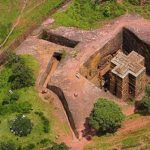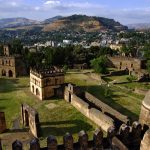Axum Obelisk
Registered as World Heritage in 1980, the ruins of the ancient city of Axum are located in Tigray region close to Ethiopia’s northern Border. They mark the location of the heart of ancient Ethiopia, when the Kingdom of Axum was the most powerful state between the Eastern Roman Empire and Persia. The massive ruins, dating from between the 1st and 13th centuries, include monolithic obelisks, giant stelae, royal tombs and the ruins of ancient castles. Long after its political decline in the 10th century, Ethiopian emperors continued to be crowned in Axum.
Beginning around the 2nd millennium BCE and continuing until the 4th century BCE there was immigration into the Ethiopian region. The immigrants came mostly from, a region of western Yemen associated with the Sabean culture. Conditions in their homelands were most probably so harsh that the only means of escape was by a direct route across the red sea into Eritrea. By the 4th century, Axum was already at its peak in land sovereignty, which included most of southern Yemen.
The city of Axum emerged several centuries before the birth of Christ, as the capital of a state that traded with ancient Greece, Egypt and Asia. Axum, whose name first appears in the 1st century AD in the Periplus of the Eritrean Sea, is considered to be the heart of ancient Ethiopia. Indeed, the kingdom which held sway over this area at this time took its name from the city. The ruins of the site spread over a large area and are composed of tall, obelisk-like stelae of imposing height, an enormous table of stone, vestiges of columns and royal tombs inscribed with Axumite legends and traditions. In the western sector of the city there are also the ruins of three castles from the 1st century AD.
The earliest records and legends suggest that it was from Axum that Makeda, the fabled Queen of Sheba, journeyed to visit King Solomon in Jerusalem. A son was born to the Queen from her union with Solomon. This son, Menilik І, grew up in Ethiopia but travelled to Jerusalem as a young man, where he spent several years before returning to his own country with the Ark of the Covenant. The Ark, according to Ethiopian belief, has remained in Axum ever since (in an annex to the church of St Mary of Zion).
Source: Authority for Research and Conservation of Cultural Heritage





Leave a Reply